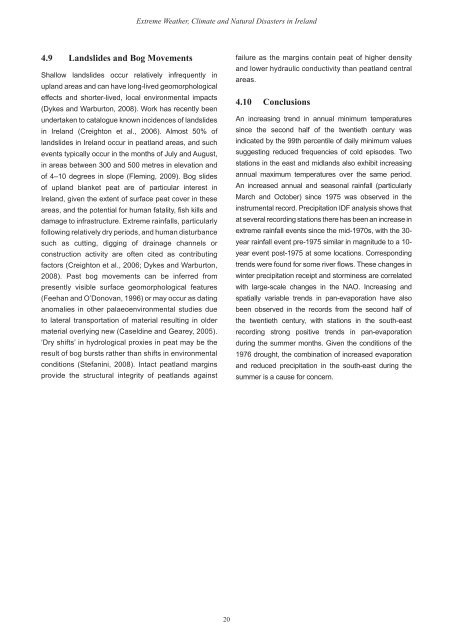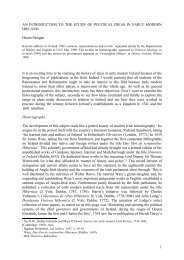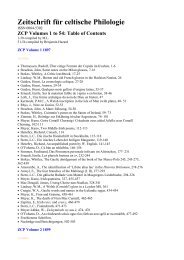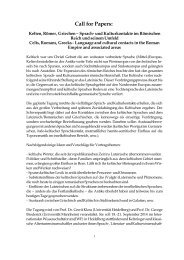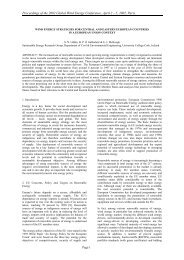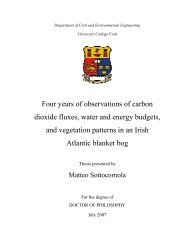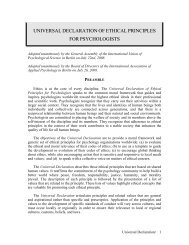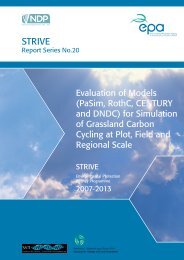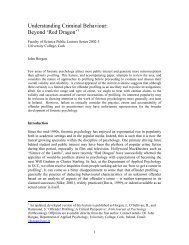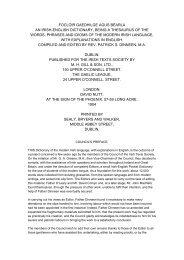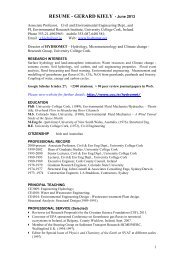Extreme Weather, Climate and Natural Disasters in Ireland
Extreme Weather, Climate and Natural Disasters in Ireland
Extreme Weather, Climate and Natural Disasters in Ireland
You also want an ePaper? Increase the reach of your titles
YUMPU automatically turns print PDFs into web optimized ePapers that Google loves.
<strong>Extreme</strong> <strong>Weather</strong>, <strong>Climate</strong> <strong>and</strong> <strong>Natural</strong> <strong>Disasters</strong> <strong>in</strong> Irel<strong>and</strong><br />
4.9 L<strong>and</strong>slides <strong>and</strong> Bog Movements<br />
Shallow l<strong>and</strong>slides occur relatively <strong>in</strong>frequently <strong>in</strong><br />
upl<strong>and</strong> areas <strong>and</strong> can have long-lived geomorphological<br />
effects <strong>and</strong> shorter-lived, local environmental impacts<br />
(Dykes <strong>and</strong> Warburton, 2008). Work has recently been<br />
undertaken to catalogue known <strong>in</strong>cidences of l<strong>and</strong>slides<br />
<strong>in</strong> Irel<strong>and</strong> (Creighton et al., 2006). Almost 50% of<br />
l<strong>and</strong>slides <strong>in</strong> Irel<strong>and</strong> occur <strong>in</strong> peatl<strong>and</strong> areas, <strong>and</strong> such<br />
events typically occur <strong>in</strong> the months of July <strong>and</strong> August,<br />
<strong>in</strong> areas between 300 <strong>and</strong> 500 metres <strong>in</strong> elevation <strong>and</strong><br />
of 4–10 degrees <strong>in</strong> slope (Flem<strong>in</strong>g, 2009). Bog slides<br />
of upl<strong>and</strong> blanket peat are of particular <strong>in</strong>terest <strong>in</strong><br />
Irel<strong>and</strong>, given the extent of surface peat cover <strong>in</strong> these<br />
areas, <strong>and</strong> the potential for human fatality, fish kills <strong>and</strong><br />
damage to <strong>in</strong>frastructure. <strong>Extreme</strong> ra<strong>in</strong>falls, particularly<br />
follow<strong>in</strong>g relatively dry periods, <strong>and</strong> human disturbance<br />
such as cutt<strong>in</strong>g, digg<strong>in</strong>g of dra<strong>in</strong>age channels or<br />
construction activity are often cited as contribut<strong>in</strong>g<br />
factors (Creighton et al., 2006; Dykes <strong>and</strong> Warburton,<br />
2008). Past bog movements can be <strong>in</strong>ferred from<br />
presently visible surface geomorphological features<br />
(Feehan <strong>and</strong> O’Donovan, 1996) or may occur as dat<strong>in</strong>g<br />
anomalies <strong>in</strong> other palaeoenvironmental studies due<br />
to lateral transportation of material result<strong>in</strong>g <strong>in</strong> older<br />
material overly<strong>in</strong>g new (Caseld<strong>in</strong>e <strong>and</strong> Gearey, 2005).<br />
‘Dry shifts’ <strong>in</strong> hydrological proxies <strong>in</strong> peat may be the<br />
result of bog bursts rather than shifts <strong>in</strong> environmental<br />
conditions (Stefan<strong>in</strong>i, 2008). Intact peatl<strong>and</strong> marg<strong>in</strong>s<br />
provide the structural <strong>in</strong>tegrity of peatl<strong>and</strong>s aga<strong>in</strong>st<br />
failure as the marg<strong>in</strong>s conta<strong>in</strong> peat of higher density<br />
<strong>and</strong> lower hydraulic conductivity than peatl<strong>and</strong> central<br />
areas.<br />
4.10 Conclusions<br />
An <strong>in</strong>creas<strong>in</strong>g trend <strong>in</strong> annual m<strong>in</strong>imum temperatures<br />
s<strong>in</strong>ce the second half of the twentieth century was<br />
<strong>in</strong>dicated by the 99th percentile of daily m<strong>in</strong>imum values<br />
suggest<strong>in</strong>g reduced frequencies of cold episodes. Two<br />
stations <strong>in</strong> the east <strong>and</strong> midl<strong>and</strong>s also exhibit <strong>in</strong>creas<strong>in</strong>g<br />
annual maximum temperatures over the same period.<br />
An <strong>in</strong>creased annual <strong>and</strong> seasonal ra<strong>in</strong>fall (particularly<br />
March <strong>and</strong> October) s<strong>in</strong>ce 1975 was observed <strong>in</strong> the<br />
<strong>in</strong>strumental record. Precipitation IDF analysis shows that<br />
at several record<strong>in</strong>g stations there has been an <strong>in</strong>crease <strong>in</strong><br />
extreme ra<strong>in</strong>fall events s<strong>in</strong>ce the mid-1970s, with the 30-<br />
year ra<strong>in</strong>fall event pre-1975 similar <strong>in</strong> magnitude to a 10-<br />
year event post-1975 at some locations. Correspond<strong>in</strong>g<br />
trends were found for some river flows. These changes <strong>in</strong><br />
w<strong>in</strong>ter precipitation receipt <strong>and</strong> storm<strong>in</strong>ess are correlated<br />
with large-scale changes <strong>in</strong> the NAO. Increas<strong>in</strong>g <strong>and</strong><br />
spatially variable trends <strong>in</strong> pan-evaporation have also<br />
been observed <strong>in</strong> the records from the second half of<br />
the twentieth century, with stations <strong>in</strong> the south-east<br />
record<strong>in</strong>g strong positive trends <strong>in</strong> pan-evaporation<br />
dur<strong>in</strong>g the summer months. Given the conditions of the<br />
1976 drought, the comb<strong>in</strong>ation of <strong>in</strong>creased evaporation<br />
<strong>and</strong> reduced precipitation <strong>in</strong> the south-east dur<strong>in</strong>g the<br />
summer is a cause for concern.<br />
20


